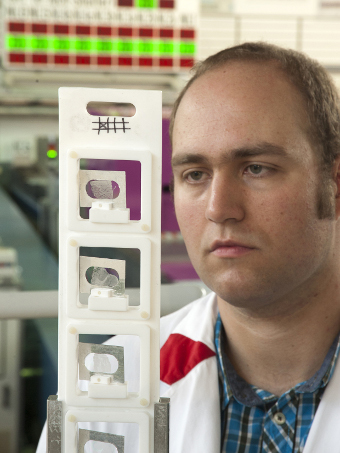Neutronen zeigen Anreicherung von Antidepressivum im Gehirn
Lithium im Gehirn
Neutronen zeigen Anreicherung von Antidepressivum im Gehirn
Nachrichten aus dem Physik-Department – 2013-09-27

Experimente mit Neutronen an der Technischen Universität München (TUM) zeigen, dass sich in der weißen Gehirnsubstanz das Antidepressivum Lithium stärker anreichert als in der grauen. Das lässt vermuten, dass es anders wirkt als synthetische Psychopharmaka. Die Gewebestücke wurden an der Forschungs-Neutronenquelle Heinz Maier-Leibnitz (FRM II) der TUM mit einem eigens entwickelten Detektor untersucht, um eine genaue Landkarte der Verteilung von Lithium im Gehirn anzufertigen und so die Wirkung des Stoffs auf die menschliche Psyche besser verstehen zu können.
Bekannt ist Lithium vor allem aufgrund seines Einsatzes in wieder aufladbaren Batterien. Doch seit Jahrzehnten wird Lithium auch in der Behandlung bei so verschiedenen psychischen Erkrankungen wie Depressionen, Manien und bipolaren Störungen eingesetzt. Die genaue biologische Wirkungsweise in bestimmten Gehirnregionen ist jedoch noch kaum verstanden. Bekannt ist, dass Lithium die Stimmung aufhellt und das Aggressionspotential senkt.
Weil es sehr schwer zu dosieren ist, scheuen sich Ärzte, dieses „Universalmedikament“ einzusetzen. Mehrere internationale Studien haben jedoch gezeigt, dass ein höherer natürlicher Lithiumgehalt im Trinkwasser zu einer niedrigeren Suizidrate in der Bevölkerung führt. Denn Lithium wird auch bei unbehandelten Personen im Gehirn eingelagert. Deshalb könnte Lithium, das bisher noch als relativ unbedeutend angesehen wurde, ein essentielles Spurenelement für den Menschen sein.
Lithiumnachweis mit Neutronen
Dem geht nun Josef Lichtinger in seiner Doktorarbeit am Lehrstuhl für Physik der Hadronen und Kerne (E12) der TUM nach. Von der Rechtsmedizin der Ludwig-Maximilians-Universität München (LMU) erhielt er Gewebeproben von Patienten, die mit Lithium behandelt wurden, unbehandelten Patienten und gesunden Vergleichspersonen. Diese setzte der Physiker am Messplatz der Prompten Gamma Aktivierungsanalyse am FRM II einem fokussierten kalten Neutronenstrahl höchster Intensität aus.
Lithium reagiert sehr spezifisch mit Neutronen und zerfällt in ein Helium- sowie ein Tritiumatom. Mit einem speziellen Detektor, den Josef Lichtinger entwickelt hat, können deshalb so geringe Mengen wie 0,45 Nanogramm Lithium pro Gramm Gewebe gemessen werden. „So genau wie mit Neutronen kann man das mit keiner anderen Methode nachweisen“, sagt Jutta Schöpfer, Rechtsmedizinerin an der LMU, die mehrere Forschungsprojekte zur Lithiumverteilung im menschlichen Körper betreut.
Lithium wirkt auf die Nervenbahnen
Seine Ergebnisse erstaunen: Nur bei den Proben eines depressiven Patienten, der mit Lithium behandelt worden war, beobachtete Josef Lichtinger eine höhere Anreicherung des Lithium in der sogenannten weißen Substanz. Das ist der Bereich im menschlichen Gehirn, in dem die Nervenbahnen laufen. Der Lithiumgehalt in der benachbarten grauen Substanz war 3-4-fach geringer. Die Lithium-Anreicherung in der weißen Substanz konnte bei mehreren unbehandelten depressiven Patienten dagegen nicht beobachtet werden. Das weist darauf hin, dass Lithium nicht wie andere Psychopharmaka im Zwischenraum der Nervenzellen wirkt, sondern in den Nervenbahnen selbst.
Nun will Josef Lichtinger weitere Gewebeproben an der Forschungs-Neutronenquelle in Garching untersuchen, um seine Ergebnisse zu bestätigen und zu erweitern. Am Ende des Projekts steht eine Landkarte des Gehirns eines gesunden und eines depressiven Patienten, die ortsaufgelöst die Lithiumanreicherung zeigt. So könnte man das Universalmedikament Lithium zukünftig noch zielgenauer und kontrollierter gegen psychische Erkrankungen einsetzen. Die Arbeit wird von der Deutschen Forschungsgemeinschaft (DFG) unterstützt.
- Redaktion
- Andrea Voit / Andreas Battenberg
Publikation
- Lichtinger et. al
Position sensitive measurement of lithium traces in brain tissue with neutrons,
Kontakt
Josef Lichtinger
Physik-Department E12
Technische Universität München
James-Franck-Str. 1
85748 Garching, Germany